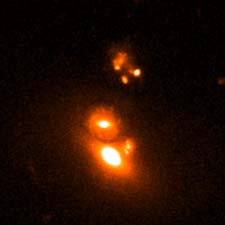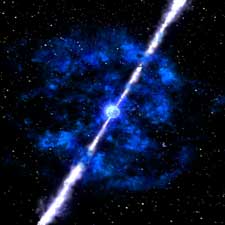When's a gamma-ray burst not a gamma-ray burst? Easy — when it doesn't give off gamma rays! That answer may sound simplistic, but it could hold the key to a scientific mystery.

Taken last December in red light with the Hubble Space Telescope's Advanced Camera for Surveys, this 10-arcsecond-wide false-color image shows two systems of interacting galaxies, the northern (uppermost) of which briefly hosted a fading 'star' — the afterglow of an X-ray-emitting explosion called XRF 020903 in the constellation Aquarius.
Courtesy Alicia Soderberg.
Most aficionados agree that the brief, apparently random flashes of highly energetic photons known as gamma-ray bursts (or GRBs) are born when a massive, rapidly rotating star dies, exhausting its internal nuclear fuel and collapsing abruptly. The collapse forms a spinning black hole in the dying star's core. The black hole then gobbles up nearby star-stuff, only to spit some of it back out, spewing jets of particles that slam into the star's outer layers at near-light speeds.
Among the many signatures of this cosmic train wreck: a burst of gamma rays visible to anyone who happens to be looking at one of the jets head-on — even if they live on the other side of the observable universe.
But what if the jet doesn't quite point directly at our solar system or the dying star is so distant that its gamma rays have been redshifted into the X-ray portion of the electromagnetic spectrum? Then Earth-orbiting telescopes might discern a flash of lesser X-rays from a star-forming galaxy billions of light-years away.

The jets emerging from a GRB progenitor smash into surrounding material, and the resulting shocks generate energetic photons that can be seen billions of light-years away.
Courtesy NASA, Dana Berry, and SkyWorks Digital.
Sure enough, astronomers have catalogued several dozen of these gamma-ray-poor X-ray flashes (or XRFs) and traced three of them to faint, amorphous galaxies that appear to be forming stars rapidly — just the kind of setting apparently favored by GRBs.
Furthermore, a spectrum places the host galaxy of one September 3, 2002, XRF (pictured above) nearly 3 billion light-years from Earth. Along with a string of observations made with radio telescopes, this distance — the first measured accurately for an X-ray flash — implies that XRF 020903 packed nearly as much punch as the typical GRB, according to an online report by Caltech graduate student Alicia Soderberg.
While announced in back-to-back press releases occasioned by last week's GRB conference in Santa Fe, New Mexico, the discoveries are hardly news: they were announced, like most GRB data, in near-real time on the GRB Coordinates Network (or GCN) Web page used
to coordinate observations by professional and amateur astronomers alike. Nor is there a consensus on the flashes' origins, though some kind of kinship to GRBs seems likely.
 0
0
Comments
You must be logged in to post a comment.